641 Sizing Up a Lurcher
SIZING UP A LURCHER
by David Hancock

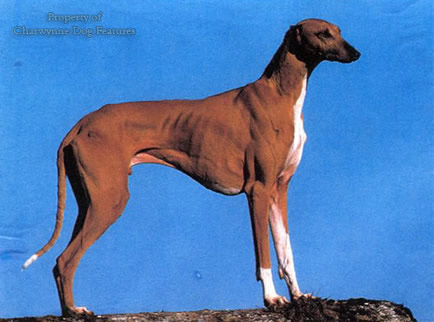
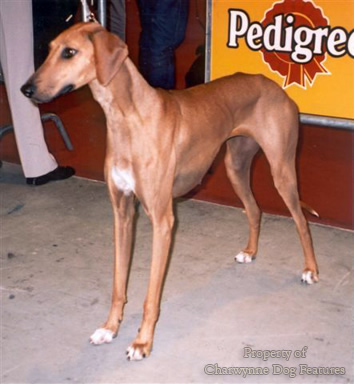 The show ring recognises just one type of standardised Greyhound but sportsmen throughout the ages have known that function, quarry and terrain all combine to give you the hound. In his informative The Pursuit of Wild Animals for Sport of 1856, JH Walsh, also known as 'Stonehenge', described variously: the Newmarket Greyhound, the Lancashire Greyhound, the Wiltshire Greyhound, the smooth Scottish Greyhound and the Yorkshire Greyhound. He wrote that 'during the last 12 years in which the Newmarket blood has been so much tried at the Waterloo-cup meeting, greyhounds of the true Lancashire breed have been victorious four times, whilst the true Newmarket have succeeded twice.' Ireland has long been famous for her Greyhounds. Cornwall was once a source of good stock and sighthounds have long been respected as valuable pot-fillers rather than statuesque exhibition animals.
The show ring recognises just one type of standardised Greyhound but sportsmen throughout the ages have known that function, quarry and terrain all combine to give you the hound. In his informative The Pursuit of Wild Animals for Sport of 1856, JH Walsh, also known as 'Stonehenge', described variously: the Newmarket Greyhound, the Lancashire Greyhound, the Wiltshire Greyhound, the smooth Scottish Greyhound and the Yorkshire Greyhound. He wrote that 'during the last 12 years in which the Newmarket blood has been so much tried at the Waterloo-cup meeting, greyhounds of the true Lancashire breed have been victorious four times, whilst the true Newmarket have succeeded twice.' Ireland has long been famous for her Greyhounds. Cornwall was once a source of good stock and sighthounds have long been respected as valuable pot-fillers rather than statuesque exhibition animals.
There is a need too to respect the noble heritage of the Greyhound, this breed is so much more than a 'grey hound'. As with far too many breed titles, with the Tibetan breeds of dog standing out as classic examples, that of the Greyhound is misleading. The inclusion of the letter 'Y' in the Greyhound's breed name gives an immediate hint that this breed earned its title from being a hound distinctly grey. The importance of this mis-spelling lies in the fact that gre-hund meant a 'noble, great, choice or prize-hound'. Three notable authorities: Jesse, Dalziel and Baillie-Grohman, all agree on this; their word is good enough for me. 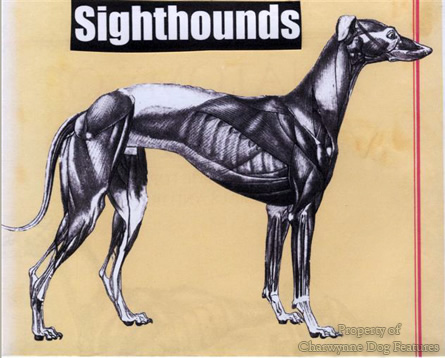
A Welsh proverb stated that a gentleman might be known, and judged, "by his hawk, his horse and his greyhound". By a law of Canute, a greyhound was not to be kept by any person inferior to a gentleman. The greyhound was clearly the companion of noblemen and deserves the more distinctive title of Grehund or noble hound. Confusingly, in the Middle Ages, the word Greyhound was used loosely to refer to such diverse types as the Irish Wolfhound, the Scottish Deerhound and the dainty diminutive Italian Greyhound.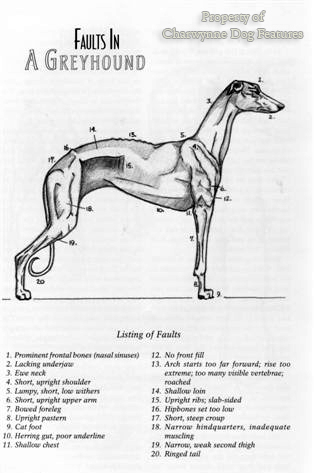
Such dogs were the close companions of men involved in war and travel to far-offcountries. It is therefore most unwise to link the contemporary breed of Greyhound with portraits of such men. Caius, in 1576, made extensive reference to the greyhound, by name, calling it in Latin: Leporarius, after its hare-hunting employment. He made quite separate reference to the gazehound, quite clearly regarding the latter as a par force hound, not a sighthound. The par force hounds made the hunt into a steeplechase, hunting by sight when their prey was literally within sight, only reverting to scent when hunting in wooded or close country, or on losing sight of their quarry. A gazehound is not a sighthound by another name.
Greyhound fanciers usually make much of an early reference to the breed in England by Dame Berners in her "Boke of St Albans". But her memorable description 'Heded like a snake, and necked like a drake. Foted like a cat. Tayled like a Rat' is a clear plagiarism of Gace de la Buigne, written some time previously and not in England. The Ancient Greeks prized their sighthounds, Arrian writing: "...the fast running Celtic hounds are called vertragi in the Celtic language...these have their name from their speed...the b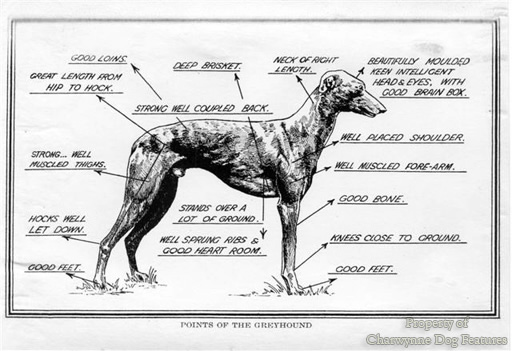 est bred of them are a fine sight." The Italian for a Greyhound is veltro, veltre in Old French, from the Celtic word guilter. The Spanish for a Greyhound is galgo, derived from gallicu, a word meaning Gaullish hound. The Galgo is now the Spanish sighthound.
est bred of them are a fine sight." The Italian for a Greyhound is veltro, veltre in Old French, from the Celtic word guilter. The Spanish for a Greyhound is galgo, derived from gallicu, a word meaning Gaullish hound. The Galgo is now the Spanish sighthound.
Is speed related to size? The weight of successful coursing Greyhounds is worth a glance. The renowned Master M'Grath was around 53lbs, Bit of Fashion was 54lbs, Golden Seal, Staff Officer, Guards Brigade, White Collar and Fitz Fife were each around 65lbs but Shortcoming only 49lb. Our show Greyhound has no stipulation regarding weight but its ideal height, for a male dog, is desired at 28-30 inches. A Deerhound dog of 30 inches at the withers would weigh around 100lbs. Does a Greyhound need to be 30" high and approaching a hundredweight? Why does a show Greyhound need to be twice the weight of a successful coursing Greyhound? The American KC standard sets the Greyhound's weight at 65-70lbs for a dog and 60-65lbs for a bitch.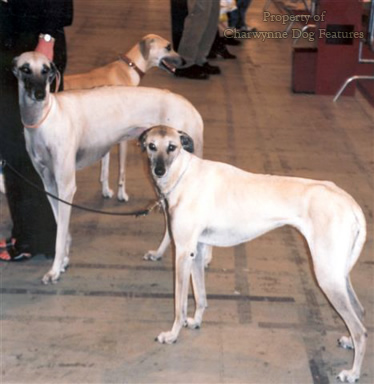
A Greyhound can cover 5/16ths of a mile in 30 seconds. In each decade the feats are repeated: in 1932, Ataxy did 525 yards in 29.56 seconds, and, in 1936, 725 yards in 41.69seconds. In 1971, Dolores Rocket did the 525 yard course in 28.52 seconds. In 1944, Ballyhennessy Seal set what was then a new world record for 500 yards in 27.64 seconds. The legendary Mick the Miller did the 600 yards in 34.01 seconds in 1930. He was spoken of as combining 'tranquillity with trackcraft'. In other words he never wasted energy nervously and used the circuit cleverly. When he died he was found to have a heart weighing 1½ ozs above the normal for a Greyhound of his size.
Of course hounds with a comparable build can also achieve great speed; a 32lb Whippet was once recorded as covering 150 yards in 8.6 seconds. This build is a superb combination of bone and muscle, a unique balance between size/weight and strength and quite remarkable coordination between fore and hind limbs. The Greyhound sprints in a series of leaps rather than running in a strict sense. It is what is termed a 'double-flight' runner, where the feet are all off the ground at the same moment. This is unlike a 'single-flight' animal like the horse which, when racing, nearly always has at least one foot on the ground.
TheGreyhound's leaping gait is rooted in quite exceptional extension, especially forward with the hind legs, but also rearwards with the front legs. Anatomically, the most vital elements in such a dog are the shoulders, and their placement, and the pelvic slope, which determines the forward extension of the all-important hind-limbs. That's where the power comes from. It always saddens me to see a sighthound in the show ring displaying upright shoulders and short upper arms, together with a lack of muscle.
The respected Greyhound expert H Edwards Clarke has written: '...perhaps the greatest fetish of the show ring is that the greyhound must be shown with lean shoulders. As galloping naturally develops muscle in the shoulders, the simple solution was that the greyhound destined for the bench must not be allowed to gallop.' Show fanciers were once advised to gallop their hounds uphill but walk them down, so that ribs, loin and hindquarters were developed but not the shoulders. It is this kind of misguided thinking which leads in different ways in different breeds to faulty development and the unwise selection of breeding stock. Once function is lost so too is type, soundness and the relationship between terrain, quarry and that function. Lurchermen know better; the pot has to be filled.
